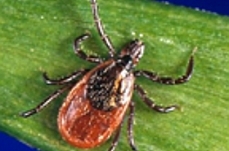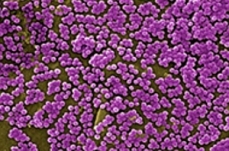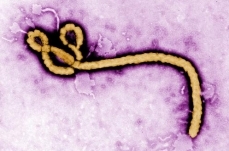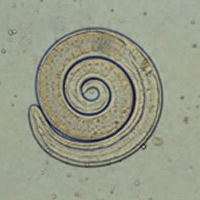Emerging Diseases (main)
From The Encyclopedia of Earth
Emerging Diseases
========
-
 Featured Article
Featured Article  Nanoparticles in Consumer ProductsThis Focus article, written by Rebecca Kessler*, appeared first in Environmental Health Perspectives—the peer-reviewed, open access journal of the National Institute of... More »
Nanoparticles in Consumer ProductsThis Focus article, written by Rebecca Kessler*, appeared first in Environmental Health Perspectives—the peer-reviewed, open access journal of the National Institute of... More »
-
 Featured News Article
Featured News Article  Wild Birds and Bird InfluenzaResearch Suggests Wild Birds May Play a Role in the Spread of Bird Flu Wild migratory birds may indeed play a role in the spread of bird flu [influenza], also known as highly... More »
Wild Birds and Bird InfluenzaResearch Suggests Wild Birds May Play a Role in the Spread of Bird Flu Wild migratory birds may indeed play a role in the spread of bird flu [influenza], also known as highly... More »
-
 Featured Article
Featured Article  Tickborne Diseases of the U.S.Tickborne Diseases of the U.S. In the United States, some ticks carry pathogens (an agent especially a virus or bacterium or other microorganism)that can cause human... More »
Tickborne Diseases of the U.S.Tickborne Diseases of the U.S. In the United States, some ticks carry pathogens (an agent especially a virus or bacterium or other microorganism)that can cause human... More »
-
 Featured Article
Featured Article  Climate Change and Public HealthMain Image: Water sprays from an open fire hydrant in Brooklyn, New York, in the midst of a July 2010 heat wave that affected much of the eastern United States. In 2007 the New... More »
Climate Change and Public HealthMain Image: Water sprays from an open fire hydrant in Brooklyn, New York, in the midst of a July 2010 heat wave that affected much of the eastern United States. In 2007 the New... More »
-
 Featured Article
Featured Article  Estimation of adult human biomassThe energy requirement of species at each trophic level is a function of the number of organisms and their average mass. The study estimates global human biomass, its... More »
Estimation of adult human biomassThe energy requirement of species at each trophic level is a function of the number of organisms and their average mass. The study estimates global human biomass, its... More »
-
 Featured Article
Featured Article  Methicillin-resistant Staphylococcus aureus...During the past four decades, methicillin-resistant Staphylococcus aureus, or MRSA, has evolved from a controllable nuisance into a serious public health concern. MRSA is... More »
Methicillin-resistant Staphylococcus aureus...During the past four decades, methicillin-resistant Staphylococcus aureus, or MRSA, has evolved from a controllable nuisance into a serious public health concern. MRSA is... More »
-
 Featured Article
Featured Article  Ebola and Marburg hemorrhagic feversEbola and Marburg hemorrhagic fevers are acute viral diseases that lead often to severe illness and death in humans and other primates. The infections typically affect multiple ... More »
Ebola and Marburg hemorrhagic feversEbola and Marburg hemorrhagic fevers are acute viral diseases that lead often to severe illness and death in humans and other primates. The infections typically affect multiple ... More »
-
 Featured Article
Featured Article  Antimicrobial resistance to drugsAntimicrobial resistance is the ability of microbes, such as bacteria, viruses, parasites, or fungi, to grow in the presence of a chemical (drug)that would normally kill... More »
Antimicrobial resistance to drugsAntimicrobial resistance is the ability of microbes, such as bacteria, viruses, parasites, or fungi, to grow in the presence of a chemical (drug)that would normally kill... More »
-
 Featured Article
Featured Article  Scented Products and VOCsA single fragrance in a product can contain a mixture of hundreds of chemicals, some of which react with ozone in ambient air to form dangerous secondary pollutants.This... More »
Scented Products and VOCsA single fragrance in a product can contain a mixture of hundreds of chemicals, some of which react with ozone in ambient air to form dangerous secondary pollutants.This... More »
Recently Updated
 Healthy Community Design Last Updated on 2014-06-29 19:10:40 The way we design and build our communities can affect our physical and mental health. Healthy community design integrates evidence-based health strategies into community planning, transportation, and land-use decisions. The U.S. Centers for Disease Control and Prevention notes that healthy community design can improve people’s health by: Increasing physical activity; Reducing injury; Increasing access to healthy food; Improving air and water quality; Minimizing the effects of climate change; Decreasing mental health stresses; Strengthening the social fabric of a community; and Providing fair access to livelihood, education, and resources. According to the World Health Organization, health is a state of complete physical, mental, and social well-being and not merely the absence of infirmity. A healthy community as described by the U.S. Department of Health and... More »
Healthy Community Design Last Updated on 2014-06-29 19:10:40 The way we design and build our communities can affect our physical and mental health. Healthy community design integrates evidence-based health strategies into community planning, transportation, and land-use decisions. The U.S. Centers for Disease Control and Prevention notes that healthy community design can improve people’s health by: Increasing physical activity; Reducing injury; Increasing access to healthy food; Improving air and water quality; Minimizing the effects of climate change; Decreasing mental health stresses; Strengthening the social fabric of a community; and Providing fair access to livelihood, education, and resources. According to the World Health Organization, health is a state of complete physical, mental, and social well-being and not merely the absence of infirmity. A healthy community as described by the U.S. Department of Health and... More »  Plastic products and estrogenic chemicals Last Updated on 2014-06-14 12:26:55 Chemicals that mimic or antagonize the actions of naturally occurring estrogens are defined as having estrogenic activity (EA), which is the most common form of endocrine disruptor activity. This article, written by Chun Z. Yang, Stuart I. Yaniger, V. Craig Jordan, Daniel J. Klein, and George D. Bittner* appeared first in Environmental Health Perspectives—the peer-reviewed, open access journal of the National Institute of Environmental Health Sciences. The article is a verbatim version of the original and is not available for edits or additions by Encyclopedia of Earth editors or authors. Companion articles on the same topic that are editable may exist within the Encyclopedia of Earth. Most Plastic Products Release Estrogenic Chemicals: A Potential Health Problem That Can Be Solved Background: Chemicals having estrogenic activity (EA) reportedly cause many adverse health... More »
Plastic products and estrogenic chemicals Last Updated on 2014-06-14 12:26:55 Chemicals that mimic or antagonize the actions of naturally occurring estrogens are defined as having estrogenic activity (EA), which is the most common form of endocrine disruptor activity. This article, written by Chun Z. Yang, Stuart I. Yaniger, V. Craig Jordan, Daniel J. Klein, and George D. Bittner* appeared first in Environmental Health Perspectives—the peer-reviewed, open access journal of the National Institute of Environmental Health Sciences. The article is a verbatim version of the original and is not available for edits or additions by Encyclopedia of Earth editors or authors. Companion articles on the same topic that are editable may exist within the Encyclopedia of Earth. Most Plastic Products Release Estrogenic Chemicals: A Potential Health Problem That Can Be Solved Background: Chemicals having estrogenic activity (EA) reportedly cause many adverse health... More »  Population Equation (Emerging Diseases) Last Updated on 2014-06-11 16:19:48 This article, written by Richard Dahl, appeared first in Environmental Health Perspectives—the peer-reviewed, open access journal of the'National Institute of Environmental Health Sciences. The article is a verbatim version of the original and is not available for edits or additions by Encyclopedia of Earth editors or authors. Companion articles on the same topic that are editable may exist within the Encyclopedia of Earth. Planet Earth, now home to about 6.5 billion human beings, has thus far disproved the doomsayers. In 1798, Rev. Thomas Robert Malthus predicted that population would outrun food supply on the assumption that human numbers would increase at a geometric rate while food would be limited to arithmetic increases. Then, in 1968, Stanford University professor Paul R. Ehrlich issued a similar warning in his book The Population Bomb, in which he predicted... More »
Population Equation (Emerging Diseases) Last Updated on 2014-06-11 16:19:48 This article, written by Richard Dahl, appeared first in Environmental Health Perspectives—the peer-reviewed, open access journal of the'National Institute of Environmental Health Sciences. The article is a verbatim version of the original and is not available for edits or additions by Encyclopedia of Earth editors or authors. Companion articles on the same topic that are editable may exist within the Encyclopedia of Earth. Planet Earth, now home to about 6.5 billion human beings, has thus far disproved the doomsayers. In 1798, Rev. Thomas Robert Malthus predicted that population would outrun food supply on the assumption that human numbers would increase at a geometric rate while food would be limited to arithmetic increases. Then, in 1968, Stanford University professor Paul R. Ehrlich issued a similar warning in his book The Population Bomb, in which he predicted... More »  Complex Systems (Emerging Diseases) Last Updated on 2013-10-24 15:13:11 As Science has begun to ask where the enduring features of nature come from and how they work, the answer seems to be “complex systems”. Every kind of thing and event seems to require them. As the science has advanced, and as the modern problems of economies and environmental conflicts emerge, a new kind of science is emerging that requires being very openly exploratory, using all the tools and combining all the related perspectives of others, to develop complex knowledge systems matching the variety of the complex system problems they respond to. Systems are storms or “like storms” in many respects, complex distributed phenomena that may be either unexpectedly eventful or highly predictable. There’s still a rather wide range of opinion within science as to what complex systems are, even whether they are made of information or... More »
Complex Systems (Emerging Diseases) Last Updated on 2013-10-24 15:13:11 As Science has begun to ask where the enduring features of nature come from and how they work, the answer seems to be “complex systems”. Every kind of thing and event seems to require them. As the science has advanced, and as the modern problems of economies and environmental conflicts emerge, a new kind of science is emerging that requires being very openly exploratory, using all the tools and combining all the related perspectives of others, to develop complex knowledge systems matching the variety of the complex system problems they respond to. Systems are storms or “like storms” in many respects, complex distributed phenomena that may be either unexpectedly eventful or highly predictable. There’s still a rather wide range of opinion within science as to what complex systems are, even whether they are made of information or... More »  Tuberculosis environment linkage Last Updated on 2013-09-17 22:27:35 This article, written by Charles W. Schmidt, a freelance writer specializing in science, medicine and technology, appeared first in Environmental Health Perspectives—the peer-reviewed, open access journal of the National Institute of Environmental Health Sciences. The article is a verbatim version of the original and is not available for edits or additions by Encyclopedia of Earth editors or authors. Companion articles on the same topic that are editable may exist within the Encyclopedia of Earth. One of the world's leading killers, tuberculosis (TB) is nearly as old as humanity itself; fossilized evidence of this lethal infection has been found in a Homo erectus skeleton half a million years old. But look to a modern hospital in a developed country, and you'd be hard pressed to find more than a few cases. Historically, TB is a disease of the... More »
Tuberculosis environment linkage Last Updated on 2013-09-17 22:27:35 This article, written by Charles W. Schmidt, a freelance writer specializing in science, medicine and technology, appeared first in Environmental Health Perspectives—the peer-reviewed, open access journal of the National Institute of Environmental Health Sciences. The article is a verbatim version of the original and is not available for edits or additions by Encyclopedia of Earth editors or authors. Companion articles on the same topic that are editable may exist within the Encyclopedia of Earth. One of the world's leading killers, tuberculosis (TB) is nearly as old as humanity itself; fossilized evidence of this lethal infection has been found in a Homo erectus skeleton half a million years old. But look to a modern hospital in a developed country, and you'd be hard pressed to find more than a few cases. Historically, TB is a disease of the... More » 